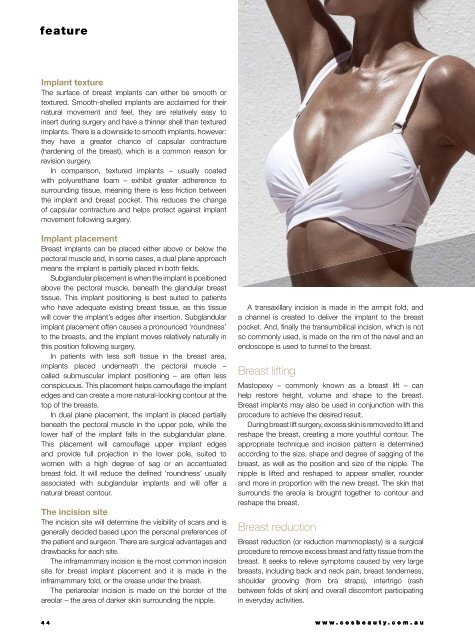Cosmetic Surgery and Beauty Magazine #68
Create successful ePaper yourself
Turn your PDF publications into a flip-book with our unique Google optimized e-Paper software.
feature<br />
Implant texture<br />
The surface of breast implants can either be smooth or<br />
textured. Smooth-shelled implants are acclaimed for their<br />
natural movement <strong>and</strong> feel, they are relatively easy to<br />
insert during surgery <strong>and</strong> have a thinner shell than textured<br />
implants. There is a downside to smooth implants, however:<br />
they have a greater chance of capsular contracture<br />
(hardening of the breast), which is a common reason for<br />
revision surgery.<br />
In comparison, textured implants – usually coated<br />
with polyurethane foam – exhibit greater adherence to<br />
surrounding tissue, meaning there is less friction between<br />
the implant <strong>and</strong> breast pocket. This reduces the change<br />
of capsular contracture <strong>and</strong> helps protect against implant<br />
movement following surgery.<br />
Implant placement<br />
Breast implants can be placed either above or below the<br />
pectoral muscle <strong>and</strong>, in some cases, a dual plane approach<br />
means the implant is partially placed in both fi elds.<br />
Subgl<strong>and</strong>ular placement is when the implant is positioned<br />
above the pectoral muscle, beneath the gl<strong>and</strong>ular breast<br />
tissue. This implant positioning is best suited to patients<br />
who have adequate existing breast tissue, as this tissue<br />
will cover the implant’s edges after insertion. Subgl<strong>and</strong>ular<br />
implant placement often causes a pronounced ‘roundness’<br />
to the breasts, <strong>and</strong> the implant moves relatively naturally in<br />
this position following surgery.<br />
In patients with less soft tissue in the breast area,<br />
implants placed underneath the pectoral muscle –<br />
called submuscular implant positioning – are often less<br />
conspicuous. This placement helps camoufl age the implant<br />
edges <strong>and</strong> can create a more natural-looking contour at the<br />
top of the breasts.<br />
In dual plane placement, the implant is placed partially<br />
beneath the pectoral muscle in the upper pole, while the<br />
lower half of the implant falls in the subgl<strong>and</strong>ular plane.<br />
This placement will camoufl age upper implant edges<br />
<strong>and</strong> provide full projection in the lower pole, suited to<br />
women with a high degree of sag or an accentuated<br />
breast fold. It will reduce the defi ned ‘roundness’ usually<br />
associated with subgl<strong>and</strong>ular implants <strong>and</strong> will offer a<br />
natural breast contour.<br />
The incision site<br />
The incision site will determine the visibility of scars <strong>and</strong> is<br />
generally decided based upon the personal preferences of<br />
the patient <strong>and</strong> surgeon. There are surgical advantages <strong>and</strong><br />
drawbacks for each site.<br />
The inframammary incision is the most common incision<br />
site for breast implant placement <strong>and</strong> it is made in the<br />
inframammary fold, or the crease under the breast.<br />
The periareolar incision is made on the border of the<br />
areolar – the area of darker skin surrounding the nipple.<br />
A transaxillary incision is made in the armpit fold, <strong>and</strong><br />
a channel is created to deliver the implant to the breast<br />
pocket. And, fi nally the transumbilical incision, which is not<br />
so commonly used, is made on the rim of the navel <strong>and</strong> an<br />
endoscope is used to tunnel to the breast.<br />
Breast lifting<br />
Mastopexy – commonly known as a breast lift – can<br />
help restore height, volume <strong>and</strong> shape to the breast.<br />
Breast implants may also be used in conjunction with this<br />
procedure to achieve the desired result.<br />
During breast lift surgery, excess skin is removed to lift <strong>and</strong><br />
reshape the breast, creating a more youthful contour. The<br />
appropriate technique <strong>and</strong> incision pattern is determined<br />
according to the size, shape <strong>and</strong> degree of sagging of the<br />
breast, as well as the position <strong>and</strong> size of the nipple. The<br />
nipple is lifted <strong>and</strong> reshaped to appear smaller, rounder<br />
<strong>and</strong> more in proportion with the new breast. The skin that<br />
surrounds the areola is brought together to contour <strong>and</strong><br />
reshape the breast.<br />
Breast reduction<br />
Breast reduction (or reduction mammoplasty) is a surgical<br />
procedure to remove excess breast <strong>and</strong> fatty tissue from the<br />
breast. It seeks to relieve symptoms caused by very large<br />
breasts, including back <strong>and</strong> neck pain, breast tenderness,<br />
shoulder grooving (from bra straps), intertrigo (rash<br />
between folds of skin) <strong>and</strong> overall discomfort participating<br />
in everyday activities.<br />
44 www.cosbeauty.com.au


















